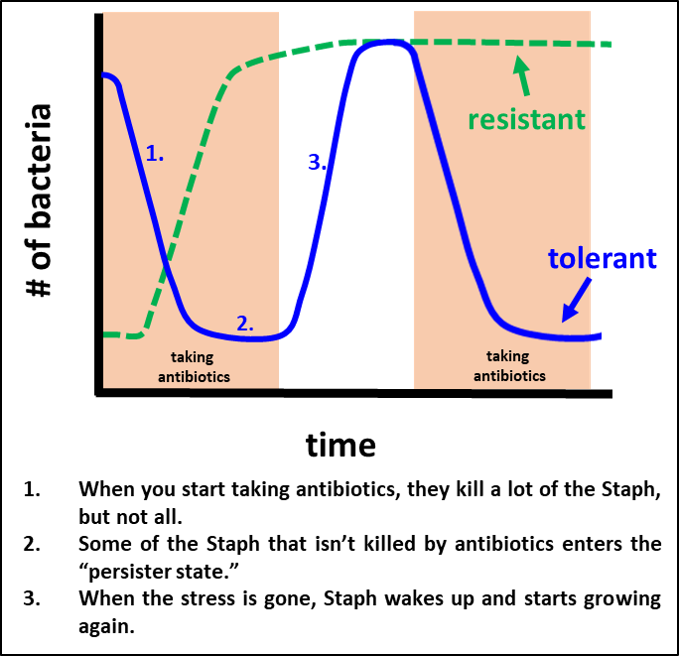By Jenna Beam

Let’s talk about Staph. If you haven’t had a Staph infection, you probably know someone who has. Those gross, oozy infections that often affect athletes (please wear shoes in the locker room y’all) are caused by the bacterium Staphylococcus aureus, but we’ll just call it Staph. Staph notoriously causes all kinds of infections, not just the skin infections we’re familiar with. It can cause pneumonia, heart infections (endocarditis), bone infections (osteomyelitis), and is the worldwide leading cause of bacterial blood infections (sepsis). Staph’s bad news. What makes it even worse is that antibiotics often don’t work to treat these infections, and even when they do, Staph comes back – up to 70% of the time.
When we talk about Staph, a lot of people talk about MRSA. MRSA stands for methicillin resistant Staphylococcus aureus. And for a while MRSA was bad. You see, the antibiotic methicillin (and its cousin oxacillin) were very commonly used to treat Staph infections for a long time…like from their discovery in the 1880s until resistance popped up in 1968…and they were really good at curing Staph infections. But through time, misuse and overuse of these antibiotics (read: taking an antibiotic when you have a viral infection or not finishing all the antibiotics your doctor prescribed) caused the development of resistance. And this was not good, but we came, we saw, and we developed new antibiotics that can work pretty well against MRSA infections. So if we have antibiotics to treat Staph infections, what’s the problem? Why are people still getting and dying from Staph infections?
The answer, my friends, may lie in antibiotic tolerance. During an infection, Staph is under a lot of stress – I’m talking like final exams, three projects due, and a recruiter at your track meet kind of stress. Your immune system is trying to kill the bacteria AND you may be taking an antibiotic. The antibiotic will work at first, but eventually all this stress sends Staph into a low energy lifestyle, or what we call a “persister state.” You know when you have so much to deal with that you decide to take a nap instead? It’s kind of like that. When Staph is napping, or in the persister state, it can’t get anything else done (like grow and divide), but it also isn’t killed by the antibiotic. However, when you stop taking the antibiotic, the stress is gone and now Staph can wake up. Once Staph is up, it gets back to growing, dividing, and causing another infection.
Keep in mind that tolerance is very different from resistance. As you can see in the graph, resistant Staph (green line) isn’t usually present at high numbers at the start of infection. However, as the antibiotic kills some of the sensitive Staph, the resistant Staph can take over. You might also notice that when Staph becomes resistant to an antibiotic, it never takes a nap. It is completely unbothered by the stress from the antibiotic and just keeps on growing and dividing and infecting.
So let’s recap – Staph is bad and sometimes resistant to antibiotics. But resistance is only part of the story. Tolerance is resistance’s evil cousin that makes the battle against bacteria even more difficult to win. Luckily, there are a lot of people trying to figure out how tolerance happens and how we can stop it from happening. So stay tuned…and stay healthy!
Edited by Elise Hickman and Mike Pablo

